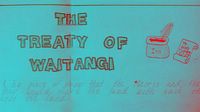
'a big piece of paper signed by the Maori and the British...to share the land...'

Waitangi Day is an important and often controversial day which celebrates an important occasion in New Zealand history. It offers a great opportunity for teachers beginning the school year to, not only learn about the Treaty, but also to develop their own set of ‘rules’ with their students for their classroom
First teachers should gather resources on the Treaty that the school will have and brush up their background knowledge so they can help their students develop a better understanding of the history and implications of the Treaty.
This needn’t become major study and many teachers make use of the Waitangi Day and the Treaty as a ‘mini’ unit’ to introduce some important ideas to the class.
Some ideas to assist:
1. Ask the children to give you their ideas of what they know or questions they have about Waitangi Day. This will provide the teacher with the students ‘prior ideas’. These will be valuable to compare with what they have learnt after the study. Display them with the heading, ‘What we think we know about Waitangi Day’. If it vague or full of misconceptions all the better.
2. From the questions students have (display as ‘What we want to find out’) get them to research answers using material you have gathered. Display these under the heading. ‘What we now know’. One way to motivate questions is to get the student to copy figures fom one of the illustration about the Treaty and then to ask them what they were thinking.
3. As a teacher you might teach your class about some of the background material about the Treaty. A good old fashioned lesson.
4. You may want to have a discussion about the varying view about the Treaty and help them see positive factors or at least see that there are other views.
The above activities introduce the students to a learning process they can use in all studies they will undertake. First find out what they know, sort out key questions and then do research. This approach is often called constructivism as students learn to construct their own knowledge – if teachers help to clarify misconceptions it is better called co-constructivism.
A summary on the blackboard might be copied into their Studies Book. This would be an ideal opportunity to introduce some simple graphic and design skills. Many students have no idea of how to lay out an attractive page.If you do this expect their work to improve as the year unfolds.
As part of the ‘lesson’ discuss the behaviors they want of each other, and of you as the teacher, so as to develop an ideal classroom. Using whatever artistic skill you can muster draw idea up into a class Treaty and get all to sign.
No comments:
Post a Comment